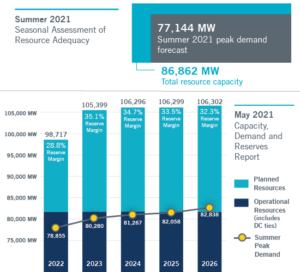The new ERCOT report also identifies low-probability and high-impact situations that could affect grid reliability.
________________________________________________
Projected hot and dry conditions — coupled with continued economic and population growth — likely will drive record-breaking electricity demand this summer. However, ERCOT, the state’s primary grid operator, predicts the state should have enough generation to meet that high demand
 In a report released May 6, ERCOT, also known as the Electric Reliability Council of Texas, projected this year’s summer peak demand at 77,144 megawatts, surpassing the current system-wide peak record set on Aug. 12, 2019 of 74,820 MW. The good news: ERCOT projects that generation on hand will exceed that projected peak by 15.7 percent.
In a report released May 6, ERCOT, also known as the Electric Reliability Council of Texas, projected this year’s summer peak demand at 77,144 megawatts, surpassing the current system-wide peak record set on Aug. 12, 2019 of 74,820 MW. The good news: ERCOT projects that generation on hand will exceed that projected peak by 15.7 percent.
Those figures and others were included in ERCOT’s final “Seasonal Assessment of Resource Adequacy” for the summer season, which the organization released this week along with its preliminary assessment for the fall season (running October through November), and its “May Capacity, Demand and Reserves” report.
The summer Seasonal Assessment of Resource Adequacy (also known as “SARA”) includes a new feature that ERCOT officials say they will include in future SARAs: the report identifies low-probability and high-impact situations that could affect grid reliability. ERCOT says this new feature will allow market participants to more fully plan and prepare for even the most remote possibilities, such as those that occurred during Winter Storm Uri.
 ERCOT projects a less than one percent chance of occurrence for the extreme scenarios it examines in the new SARA. The winter storm that occurred in February was approximately a one-in-100 event, according to ERCOT.
ERCOT projects a less than one percent chance of occurrence for the extreme scenarios it examines in the new SARA. The winter storm that occurred in February was approximately a one-in-100 event, according to ERCOT.
“The new scenarios reflect ERCOT’s commitment to improve transparency and visibility into the market and the factors that affect reliability, even when there is a very remote possibility of these events happening,” said ERCOT’s Vice President of Grid Planning and Operations Woody Rickerson, in a prepared statement.
Along with the release of its new reports this week, ERCOT also announced plans to visit selected power plants to review their summer weatherization plans. While ERCOT has visited plants in the past to check for winter weatherization, this is the first time officials will visit plants for summer weatherization, according to ERCOT.
ERCOT also has announced that it is monitoring current drought conditions in Texas. After consulting with generators on their risk mitigation plans, the grid operator does not believe that the drought poses a significant risk at this time.
PRELIMINARY FALL PROJECTIONS
While the final Seasonal Assessment of Resource Adequacy for the summer season projected potentially record-breaking usage this summer, the preliminary assessment for the fall season (running October through November) anticipates considerably less usage: 62,662 MW at its peak. The preliminary fall SARA also projects sufficient generation to meet system-wide demand under normal system conditions. However, temporary tight conditions could result under a number of scenarios, such as if a high number of maintenance outages occur during a drop in renewable energy production or during an extreme weather event.
Capacity, Demand and Reserves Report
In contrast to the SARA reports that provide near-term looks at generation availability, ERCOT’s Capacity, Demand and Reserves reports consider the system’s “planning reserve margin” over a five-year time horizon. The planning reserve margin is expressed as a percentage that represents the difference between the total generation available in the ERCOT system and the forecasted firm peak demand.
Based on information provided by resource owners and developers, ERCOT calculates the planning reserve margin for summer 2022 at a healthy 28.8 percent. This represents a 1.5 percentage point increase relative to previously reported figures. ERCOT calculates even greater summer reserve margins for 2023 through 2027 — i.e., exceeding 30 percent.
ERCOT reports that as of the end of April, utility-scale solar and battery storage projects accounted for almost 80 percent of new resources studied for interconnection to the ERCOT grid. The organization has reported that looking ahead, that it will continue to monitor new operational risks resulting from a changing resource mix.
For example, “ERCOT now sees the potential for tight conditions during low wind conditions, or during the early evening hours when solar resources come offline,” the organization stated in a recent news release. However, “as the capacity of battery storage increases in ERCOT, these resources are expected to help mitigate some of this risk.”

